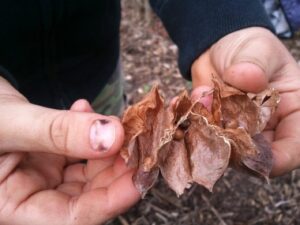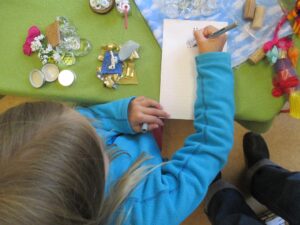Skills for Life

A few months ago, it was hard to open a newspaper or turn on the radio without running into Paul Tough and his book, How Children Succeed: Grit, Curiosity, and the Hidden Power of Character (see, for example, this episode of This American Life.) As the title suggests, the book highlights the fundamental relationship between qualities like tenacity, resilience, and impulse control, with success in school and life after school. Tough calls these “non-cognitive skills”, and Ellen Galinsky extended Tough’s arguments through directing the reader to studies which show that these traits are not just important “soft” qualities, but are, indeed, cognitive brain functions.
The traits Galinsky emphasizes are focus and self control, perspective taking, communicating, making connections, critical thinking, taking on challenges, and being a self directed learner. How do I see a playful approach to learning and immersion in the arts that makes these traits visible across the grade span in a typical week at Opal School?
Here are a few snapsots answering that question:
 In the Museum Pre-School, students come back from their walk in the woods with seeds in hand and sticking to socks. They’re curious about these treasures, sorting them and cracking them open. They wonder, How do these know what to grow into? Their theories evolve through conversation and painting.
In the Museum Pre-School, students come back from their walk in the woods with seeds in hand and sticking to socks. They’re curious about these treasures, sorting them and cracking them open. They wonder, How do these know what to grow into? Their theories evolve through conversation and painting.
In Opal 2, first and second graders consider, What is a story? Through drawings and discussions, they share their theories. One student says, “A story is what made your life because if it weren’t for stories there wouldn’t be a world.”
In Opal 3, I watch third and fourth graders investigating the idea of “quest” through a wide range of languages: Some were painting, others engaging in dramatic play, others making stop-motion video. Teacher Rob walked through the room, asking and answering questions, bouncing ideas around, filling needs as they were requested. and listening to the students – but the students were responsible for setting the path and adjusting the sails.

This week in Opal 4, fifth graders were investigating their personal gifts and what it means to give and receive them. Thursday, they were using the medium of clay to consider the question. One student explained her process of seeing how clay might guide her: “I was just playing around to see what kind of metaphor would spark in my mind, so I started with a circle because a circle is a good shape for a metaphor. Then I started working with a cutter and all these bumps came up. That made me start thinking about how sometimes gifts are hard to give, because you have trouble with your friends.”
What life skills do you see being developed in these vignettes?
How do you imagine that playful inquiry supports all of the strong skills and strategies we want a 21st child to learn?
Where else are you seeing this thinking making itself visible?

Through The Brilliant Blog (http://bit.ly/YdXoQH), I just became aware of Mike Rose’s recent piece in EdWeek covering similar terrain. His conclusion deserves reprint here:
“By all means, let us take a hard look at our national obsession with tests and scores and grades, and let us think more generously about what kinds of people we want our schools to develop. Part of such reconsideration would include a reclaiming of the full meaning of cognition—one that is robust and intellectual, intimately connected to character and social development, and directed toward the creation of a better world.”
You can read the whole piece at http://bit.ly/XK8Lfh